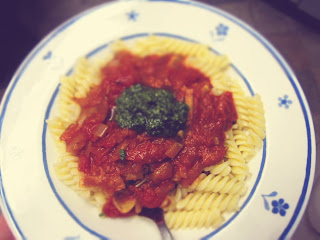To borrow a phrase from Brian Cox, I am not being unduly hyperbolic when I say that Amelie's two sauce pasta is the stuff of legend round the few weird streets of London where I live. People have been known to cross rivers (mostly the Thames), climb mountains (mainly the steps to Amelie's old flat) and brave the two-for-£5 merlot from the local offy to get their hands on a bowl of this stuff.
It may not sound like much, but when it's been left to simmer and there's 1kg of pasta boiling on the stove, somehow it just becomes the tastiest thing ever. Doused within an inch of its life with olive oil and more garlic than truly decent, this is a rich, vegan supper and can easily be made gluten-free with the addition of GF pasta.
After nearly a year of pestering, Amelie finally gave me the recipe for the two sauces last week. Since then I've tried three times to recreate it, and barely come close. So the photos here are of Amelie's two sauce pasta, and Amelie's unadulterated recipe. Because there's no way I'm about to tinker with it.
For 4 people:
2 carrots (not too big)
2 onions (red or white)
2 tins of plum tomatoes (not chopped)
6 cloves of garlic (AS MUCH AS POSSIBLE)
Good chilli (doesn't have to be spicy, it needs to have a nice chili taste) (I used piment d'espelette powder which I steal from my mum's shop. It's delicious because it gives a nice strong taste of chili without making it super spicy)
N.B.: if you use fresh chili, do not chop it as it will be too spicy (i.e. arrabbiata) Use one or two whole chili instead, and leave it in the saucepan til you serve the pasta.
Thyme
Tomato paste (optional)
Olive oil, of course - half a bottle if possible.
Basil
Start by chopping the onions, carrots, basil stems and garlic. Heat the oil in a saucepan and once it's hot, add the onions, basil stems & thyme and let the onions sweat for a bit.
Add the finely chopped carrots, the garlic and the chili and let it cook for around 10 minutes. You could also add a tablespoon of tomato paste. Add salt. Once the carrots are cooked, add the tomatoes and half a tin of water (or a bit more, depending on the thickness of the tomato juice).
DON'T crush the tomatoes yet. Let them cook nicely.
Put the lid on the saucepan but don't close the whole thing, leave some steam out. The tomatoes need to cook for 15-20 minutes, then they'll be easy to crush. After you crushed the tomatoes, the sauce will have to reduce a little bit as you will release some of the tomatoes' juice (sounds gross).
Put it on a very low heat, with the lid covering 3/4 of the pan...and leave it like this for up to 30 minutes.
It doesn't have to cook for ages and it's quite nice when you let it 'rest' for a bit before serving.
Don't forget to add salt and pepper and a SPLASH of olive oil. You could add some more chili powder too.
Voila!
Add the chopped basil leaves at the end, on the plate (and some olive oil).
OR make a pesto - olive oil, basil, 1 clove of garlic, almond or pine nuts depending on how rich you are, salt and pepper. N.B.: I don't recommend making pesto with cashew nuts...that's like fusion food gone too far.
One of the most important things about this recipe is to make sure the onions and carrots are well cooked and that the onions/carrots/garlic/chili/thyme mix is really tasty on its own.
In spring/summer you could replace the carrots with a red pepper - yummy!



















